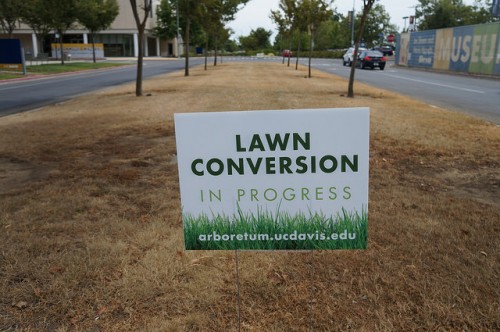Weathering the drought: on campus and at home
Over the past year the UC Davis Arboretum and Public Garden has managed to cut back water use across campus by over 30% from 2013 — that is already well above Governor Brown’s recent 25% water reduction mandate. We are proud of this accomplishment, but we are not planning to stop there. We will continue to seek reductions throughout campus and the Arboretum. In this feature we will give you an insider’s look at how we’ve managed this decrease to date, changes you’ll notice in the near future, and how we are planning for a low-water future which will hopefully give you ideas for how you can do the same.
Targeted Tree Care
Willie Hernandez, groundskeeper with the UC Davis Arboretum and Public Garden’s grounds and landscape services team, fills tree water bag called a “SeedlingSoaker.” This bags provide our smaller campus trees with a slow release of water which helps prevent water run-off while allowing the trees targeted protection from the drought.
The benefits of trees are many: they help prevent carbon from being released into the atmosphere, they provide shade, fight erosion, and so much more, but when we reduce water to our lawns that can mean we inadvertently stress the trees living there too. To help alleviate this pressure and maintain tree health we have installed over two hundred slow-release watering bags on young trees throughout campus. Each one of these bags is filled manually from our campus water truck about once a week with approximately 10-15 gallons of water which then seeps slowly from small holes in the bottom of the bag into the surrounding soil. This action not only targets young tree roots, it also reduces water run-off and evaporation. Each one of these bags saves about 1000 gallons of water a year per tree.
The best way to irrigate trees during a drought is to apply water less frequently, but more deeply. We keep our world-famous oak collection (seen above) healthy by providing the root zone with a slow, steady soak about twice a month. This method allows the water to penetrate the soil deeply—there it does not evaporate as quickly and remains available to the roots for longer.

For mature trees, like in our oak grove (see photo top right on page 1), we apply water less frequently, but more deeply. During dry months, arborists recommend watering to a depth of three feet. To assist in this effort, the California Center for Urban Horticulture at UC Davis has developed instructions for how to purchase, assemble and deploy a unique watering device called the tree ring irrigation contraption (TRIC). For more information on gathering the materials necessary to create this device and the process for assembling it, visit the Tree Ring Irrigation Contraption (TRIC) page.
Irrigation Improvements
While most of our main campus landscape irrigation is part of a high-efficiency computerized system, there are still some areas, mostly in the central part of the Arboretum, that require hand watering during the day with hoses and/or spray irrigation. Not only is this method labor intensive—it requires staff who can start, stop, and move it—it’s also inefficient because it often results in overspray and wet guests!
We do have plans to install new irrigation systems in these areas as funding becomes available, however, since installing systems from scratch is very expensive, it will need to be phased in over many years. In the meantime, the university is investing in more efficient, but temporary irrigation systems. These temporary systems will be set up this summer and allow for automated, more precise nighttime watering. As permanent systems are funded and installed, the temporary systems will be removed. LEARN MORE: How low can they go?

Lawn Conversion
The large median along Old Davis Road near the Mondavi Center for Performing Arts will be converted to a low-water, region-appropriate landscape. Signs like these placed throughout the median alert community members and visitors of the change.
Thanks to the high-efficiency, computerized system that controls watering on most of campus, we can easily target turf for irrigation reductions. Some lawns will even be allowed to go dormant through the summer. However, lawns with high-event use uses like the Quad and fields used for athletics or student recreation will continue to be maintained.
We have also identified lawns for full-scale landscape conversions. Look for this change on the median near the Mondavi Center for Performing Arts. While the trees in the lawn will be maintained, the turf will be replaced with Arboretum All-Stars, California natives, and other regionally-appropriate plants.

Regionally-Appropriate Plants
You will see low-water, regionally-appropriate plants like Arboretum All-Stars and California natives used throughout the Arboretum and on campus. Our Ruth Risdon Storer Garden is a great demonstration garden to seek inspiration!
When given the option, planting in fall is always our first choice; temperatures are dropping, but the soil is still warm. Those are ideal conditions for root development, plus, with any luck from Mother Nature, seasonal rains should be right around the corner. Plan your new drought-tolerant garden over the summer and visit our plant sales in the fall for a great selection of regionally-appropriate, low-water plants such as Arboretum All-Stars and California natives.
